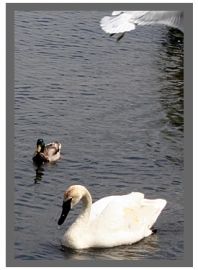Hilliardton Marsh Provincial Wildlife Area

Park Size: 725 hectares
Park Amenities:
Hilliardton Marsh Provincial Wildlife Area is a birding and sightseeing activity destination, as well as, a protected wetland for over 190+ bird species. The wetland marsh is designated as a provincially significant wetland area in Ontario, Canada.
The marsh measures around 725 hectares (1800 acres) and is divided into four cells (sections). The wildlife area is a managed wetland with pumping stations regulating water levels between each cell.
In total, there are 516 hectares of dry marsh area and 209 hectares of flooded wetland in the Hilliardton Marsh Provincial Wildlife Area. It is a combination of environments creating open water and marsh-like eco systems attracting many birds to the region.
The marsh was first constructed in 1993 as a staging area for resting, nesting and breeding birds.
During the migrating fall and spring seasons the birding activity is best attracting birdwatchers, hikers, photographers and canoeists.
There are a selection of raised berms acting as trails, exploring the marsh. Conditions of trails vary. The paths lead to once active beaver ponds, a bird blind and a 40 foot viewing tower. Throughout the marsh are bird houses and duck huts for breeding.
The Hilliardton Marsh Provincial Wildlife Area is a prime birding destination for viewing waterfowl, shorebirds, predator birds and songbirds.
Waterfowl sightings include Snow Goose, Tundra Swan, Common Loon, Red-breasted Merganser, Blue-winged Teal, Northern Pintail, Ring-necked Duck, Ruddy Duck, Bufflehead, Double-crested Cormorant, Horned Grebe, Common Goldeneye and American Coot.
Shorebird sightings include Great Blue Heron, Killdeer, Black-bellied Plover, Sandhill Crane, Spotted Sandpiper, American Woodcock, Lesser Yellowlegs, White-rumped Sandpiper, Short-billed Dowitcher and Virginia Rail.
Predator bird sightings include Great Horned Owl, Boreal Owl, Northern Hawk Owl, Long-eared Owl, Great Gray Owl, Osprey, Northern Harrier, Bald Eagle, Peregrine Falcon and American Kestrel.
Other birds to look out for include Black-billed Cuckoo, Belted Kingfisher, Common Nighthawk, Pileated Woodpecker, Yellow-bellied Sapsucker, Ruby-throated Hummingbird, Hairy Woodpecker, Downy Woodpecker, Northern Flicker, Warbling Vireo, Barn Swallow, Cedar Waxwing, American Tree Sparrow, Pine Grosbeak, Dark-eyed Junco, Horned Lark, Yellow Warbler, Wood Thrush, Purple Finch, Red-winged Blackbird, Snow Bunting and Ruby-crowned Kinglet.
Best bird sightings are enjoyed on the water from a canoe as most of the wetland cannot be accessed by trail.
Explore Hilliardton Marsh Provincial Wildlife Area, Temiskaming Shores, Ontario, Canada, Wilderness Region
Address:
